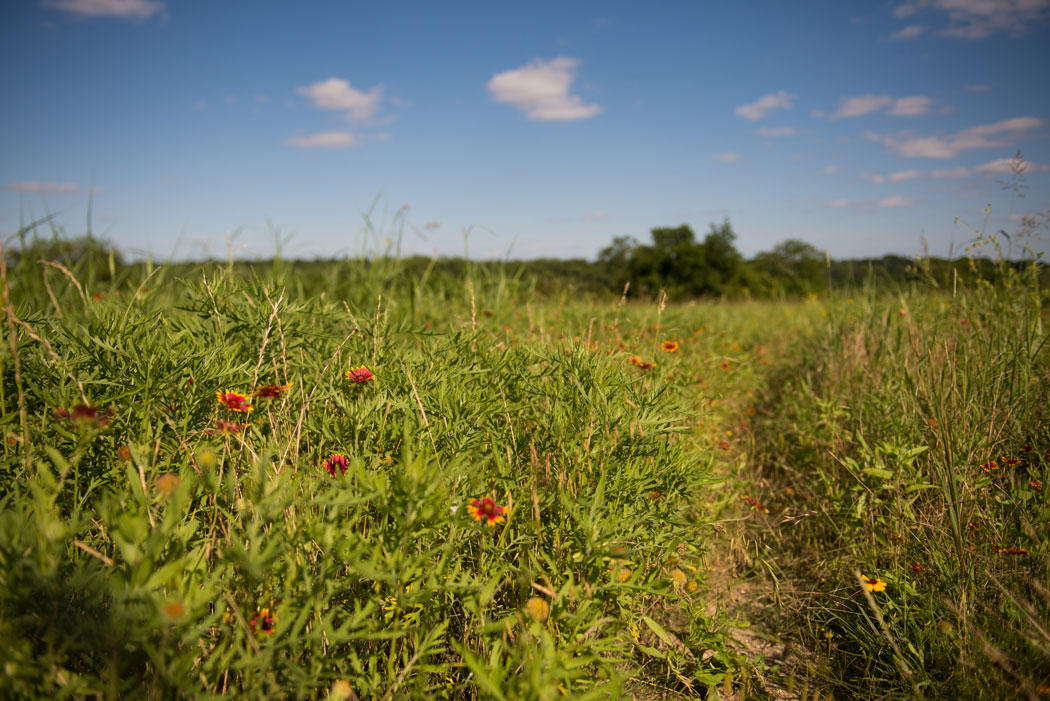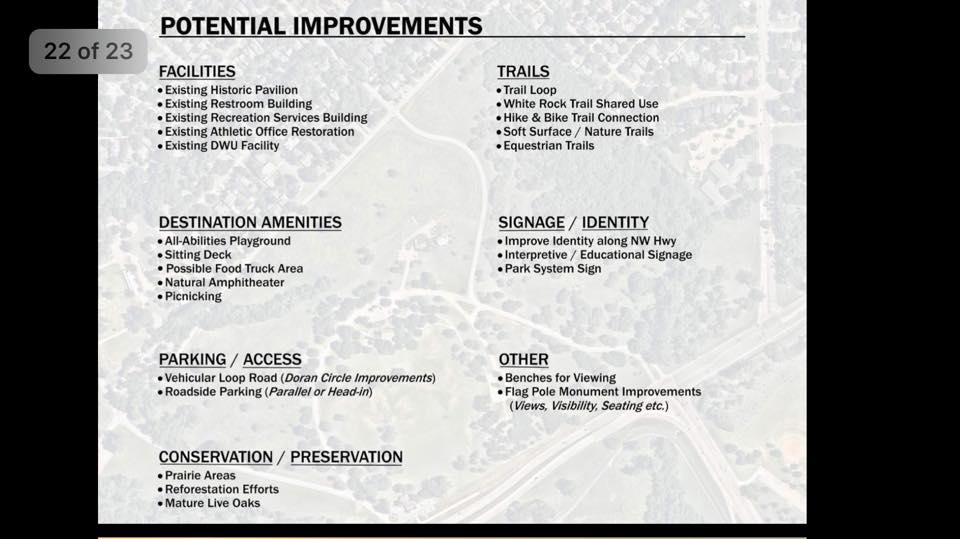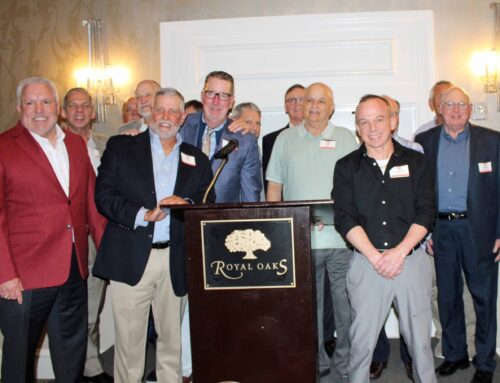By Will Maddox
A standing-room-only crowd met for Tuesday’s Flag Pole Hill Master Plan Community Meeting at Lake Highlands North Recreation Center. A polite but vocal group made themselves heard at the meeting, as staff from Dallas Parks and Recreation and landscape architects from Dunaway listened and fielded questions. The majority of community members wanted to keep the park’s natural beauty and green open space in the heart of the city.
As Dallas proper continues to grow and become denser, large urban parks such as Flag Pole Hill become even more important to the vitality and balance of the city. Many attendees stressed the importance of preserving this park and keeping it as a natural space where the destinations are serene natural beauty, not concerts, food trucks, or other large, traffic- and noise-heavy events.
District 10 City Council member Adam McGough opened the meeting, sharing his love and passion for the park that lies just inside his district’s borders. “Flag pole hill is an asset to our Dallas community,” he says. “The day after I was elected, I went to the park to spend some quiet time in prayer and reflect on the campaign. It is important part of our entire community and city.”
The next phase of the meeting was led by Elizabeth McIlrath and Philip Neely representing Dunaway, a landscape architecture firm the city hired to work on the master plan for the park. They presented the process and some potential improvements. Prior to this meeting, Dunaway had been gathering data, analyzing the site to evaluate opportunities and constraints. They are now in the program development stage and will move into the concept development stage after receiving the community input from the meeting. Next will be the preliminary Master Plan with cost estimates, and then a Final Master Plan will be presented to city leaders, who will decide what gets funded and built.
Dunaway’s potential improvements included protecting and restoring the original Works Progress Administration buildings, conserving the rare Blackland Prairie, mature Live Oak trees and wooded areas, improving trails, and giving the outdated playground a makeover so that it is an accessible playground for those with disabilities. Other suggested improvements were to build more destination amenities, such as an amphitheater for concerts and space for food trucks. “I have been working in and around White Rock Lake for 10 to 12 years, and projects like this are a dream job for people like us,” McIlrath said.
After presenting the suggested improvements, Neely fielded questions and comments from the audience. While a range of comments were heard, the most raucous and positive responses were to those that focused on preserving the open space and natural beauty of the park while avoiding more concrete or traffic.
After several comments, neighbor Patti Smith, who has lived near Flag Pole Hill for over 20 years, summed things up to much fanfare and applause. “The commonality seems to be to keep the park natural and celebrate the rustic natural beauty, like an oasis in this big city. If we had destination amenity improvements, it would increase traffic and noise and would disturb the natural beauty. People come here to feel like they are out in the country.”
Part of the natural beauty is the Blackland Prairie that exists in the park. One area in the park contains gilgai within the prairie. Gilgai are temporary lakes that are formed in small depressions in the expanding soils of the Prairie. The prairie specimen in the northwest part of Flag Pole Hill is one of 25 such sites in the entire world, according to Dallas Parks representatives.
Another topic of discussion was the playground at Flag Pole Hill. Neighbors commented about how it is one of the few shaded playgrounds in the area, and is well supplied with expansive Live Oak trees. Others lamented the lack of access to the playground for wheelchair bound or disabled children and adults. Many hoped for a remade playground that is more accessible to all.
There were also several complaints and comments about the safety of Lanshire, a road adjacent to the park’s northwest boundary. This narrow two-lane road lacks sidewalks and has 40 mph traffic, yet is one the most common access points for the park for pedestrians and cyclists. One neighbor commented, “We live on Lanshire and watch the game of Frogger every morning. We see moms in strollers and bicycles coming along, and they can’t see what is coming right at them.”
Everything from guided nature walks to kayak paddling trails was discussed. In addition, a White Rock Stables representative made an impassioned plea to keep their equestrian trails in mind, which run through the eastern half of the park. The stables have been around for 40 years and are adjacent to the park.
One of the loudest uproars came from a fiery man in cowboy boots, who yelled out of turn from his seat in the back. “What needed to change? What happened to make everyone think it needed to be changed? I’ve been here for 30 years, and its fine.”
Neighbor Noble Harris, who has lived in the area since 1958, teared up as he made his plea to keep Flag Pole Hill the way it is. “I have lived behind Flag Pole Hill for 50 years. I have canoed, biked, and I love it the way it is. I see no reason to change anything.”
After receiving the input, Dunaway will make another community presentation with their general Concept Development. This won’t have specifics but will be a general idea of what will be done with park. They will seek community input at this stage before creating their preliminary master plan, which will have more specifics about what will be done, and what will be left alone. Check back for more information on when the next community input meeting will be for the Flag Pole Hill Master Plan.







